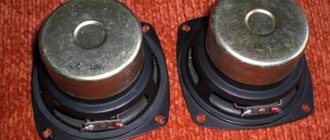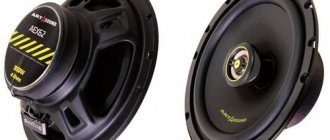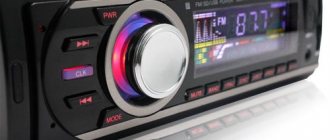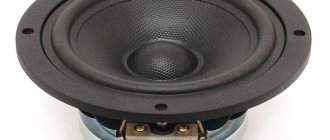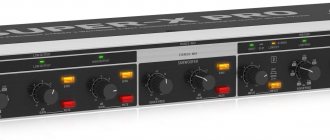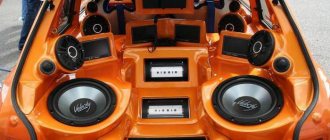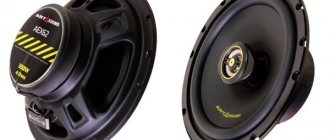- home
- Articles
- How to choose a speaker | ACTON
|
|
There are many different types of sound emitters, but the most common are electromagnetic type emitters, or as they are also called, speakers.
Speakers are the main structural elements of acoustic systems (AS). Unfortunately, one speaker is not capable of reproducing the entire audible frequency range. Therefore, for full-range reproduction in acoustic systems, several speakers are used, where each is designed to reproduce its own frequency band. The operating principles of low-frequency (LF) and high-frequency (HF) speakers are the same; the differences lie in the implementation of individual structural elements.
The operating principle of the speaker is based on the interaction of an alternating magnetic field created by a current flowing through the wire of a magnetic coil with the magnetic field of a permanent magnet.
Despite the comparative simplicity of the design, speakers intended for use in high-quality acoustic systems have a large number of important parameters on which the final sound of the acoustic system depends.
The most important indicator characterizing a speaker is the reproduced frequency band. It can be indicated as a pair of values (lower limit and upper limit frequency), or given in the form of an amplitude-frequency response (AFC). The second option is more informative. The frequency response is a graphical dependence of the sound pressure level created by a speaker at a distance of 1 meter along the working axis on frequency. The frequency response allows you to evaluate the frequency distortions introduced by the speaker into the original signal, and also, in the case of using the speaker as part of a multi-band system, to identify the optimal value of the crossover filter frequency. It is the frequency response that allows a speaker to be classified as low-frequency, mid-frequency or high-frequency.
Selecting a subwoofer
For LF speakers, in addition to the frequency response, an essential group of indicators are the so-called Thiel-Small parameters. Based on them, the acoustic design parameters for the speaker (speaker system housing) are calculated. The minimum set of parameters is resonant frequency - fs, total quality factor - Qts, equivalent volume - Vas.
The Thiel-Small parameters describe the behavior of the speaker in the piston-action region (below 500Hz), considering it as an oscillating system. Together with the acoustic design (AO), the speaker is a high-pass filter (HPF), which allows the use of mathematical tools borrowed from filter theory in calculations.
An assessment of the Thiel-Small values of the speaker parameters, and first of all, the total quality factor Qts, allows us to judge the advisability of using the speaker in acoustic systems with one or another type of acoustic design (AO). For speakers with phase-inverted acoustic design, speakers with a total quality factor of up to 0.4 are mainly used. It is worth noting that phase-inverted systems are the most demanding, from a design point of view, compared to speakers that have a closed and open AO. This design is sensitive to errors made in calculations and in the manufacture of the housing, as well as when using unreliable values for the parameters of the woofer.
When choosing a woofer, the Xmax parameter plays an important role. Xmax shows the maximum permissible displacement of the cone, at which a constant number of turns of voice coil wire is maintained in the gap of the speaker magnetic circuit (see figure below).
For satellite speaker systems, speakers with Xmax = 2-4mm are suitable. For subwoofers, speakers with Xmax=5-9mm should be used. At the same time, the linearity of the conversion of electrical vibrations into acoustic ones at high powers (and, accordingly, large vibration amplitudes) is maintained, which manifests itself in more efficient low-frequency radiation.
If you have decided to make a speaker system with your own hands, you will inevitably be faced with the question of choosing branded components, including the frequency of the speakers. Without experience in using products from different manufacturers, it is sometimes difficult to make the best choice. You have to be guided by many factors and compare according to many parameters, not only those related to passport characteristics. ACTON speakers will successfully complement your speaker system because, in addition to high quality, they have a number of advantages:
- have an optimal price/quality ratio in their segment;
- the speakers are specially designed for professional speakers used for dubbing social and cultural events;
- documentation for the manufacture of housings has been developed for speakers;
- interaction between the consumer and the manufacturer is carried out directly without intermediaries, which avoids problems with the availability of any spare parts and components;
- information support on the design of speakers;
- high reliability of ACTON speakers.
You can view the ACTON speaker range here.
Bass
Subwoofers are designed to handle the lower frequency range (sound waves) of the speaker system, and there are several different types, depending on your needs. Although they are all built in a very similar way, there are certain differences between each type:
- Standard Subwoofer : The standard subwoofer produces frequencies from 20 to 2000 Hz (2 kHz or 2 kHz). A woofer is often characterized by its bass sound, which comes from a low-frequency sine wave. Typically, you'll see standard woofers as part of high-end speakers that contain either a woofer and a tweeter (a setup known as a 2-way speaker) or a woofer, a tweeter, and a midrange speaker (a setup known as a 3-way speaker).
- Subwoofer: Subwoofers are capable of reproducing tones below 200 Hz in user systems. They consist of one or more subwoofers, often mounted inside a wooden cabinet. Although the human ear can only perceive frequencies up to 12 Hz, subwoofers operating at lower frequencies can only be felt, if not heard. Subwoofers are the most common addition to a speaker setup. They are typically housed in their own insulated enclosure and provide low noise levels that you simply can't get with standard woofers.
- Midwoofer: Midwoofers fall right in the middle of the "subwoofer" range, starting from 200 Hz -5 kHz. With such a wide frequency range, this speaker will produce the best quality audio from 500Hz-2kHz and will start to degrade on both ends of the spectrum.
- Rotating Woofer : A rotating woofer is a woofer-style speaker that uses the movement of a coil to change the height of a set of fan blades instead of using a cone shape. Since the height of the blades is changed by the audio amplifier, the power required is much less than that of a conventional subwoofer. They are also far superior at producing sounds well below 20 Hz, below normal levels of human hearing, capable of producing frequencies as low as 0 Hz by compressing air in a closed room.
In most custom speaker systems, you will likely find a standard woofer as part of the main speakers, and perhaps an additional but separate subwoofer.
Selecting a tweeter
When choosing a tweeter, the frequency response determines the lower frequency of the range it reproduces. It is necessary that the frequency band of the tweeter somewhat overlaps the frequency band of the woofer.
Some tweeters are designed to work in conjunction with a horn. Unlike direct-radiation tweeters (or tweeters, as they are called), horn tweeters, due to the properties of the horn, have a lower cutoff frequency of the reproduced audio range. The lower limiting frequency of such a high-frequency speaker can be approximately 2000-3000 Hz, which makes it possible in many cases to abandon the midrange speaker in the speaker system.
Due to their design, tweeters tend to have higher sensitivity than woofers. Therefore, at the filter design stage, an attenuator (suppressor) circuit is provided in it, which is necessary to reduce excess radiation, which brings the sensitivities of the high-frequency and low-frequency speakers to the same level.
When choosing a tweeter, it is important to consider its power, which is selected based on the power of the woofer. In this case, the power of the HF speaker is taken lower than the power of the LF speaker, which follows from the analysis of the spectral density of the audio signal, corresponding to pink noise (which has a decline towards high frequencies). For a practical calculation of the power dissipated by the high-frequency dynamics in speakers with a crossover frequency of 3-5 kHz, you can use the calculator on our website.
Let us remind you that HF speakers cannot be used without a high-pass filter (HPF), which limits the penetration of the low-frequency part of the spectrum.
How to choose broadband speakers for a car
If a car enthusiast listens to the radio or music in the background, then such acoustics will be a suitable option. The driver will be able to listen to music and radio shows and save on installing acoustic equipment.
When choosing acoustics for a car, you need to evaluate the characteristics:
- Standard size. This is a standard that specifies the geometric dimensions of speakers. In cars, the factory design provides standard places for installing acoustics. These points are designed for oval or round speakers. Standard sizes are 10, 13, 16 cm, but the manufacturer can indicate in inches. You cannot modify regular seats yourself. This will cause the seal to fail, which means the sound will deteriorate. The larger the speaker size, the fewer problems with reproducing the low-frequency range.
- Frequency. Manufacturers indicate the value of the indicator in the technical documentation. Since such acoustics have dips in the low and high frequency ranges, you need to look for speakers whose lower limit is less than 20 Hz and the upper limit is 48 kHz.
- Sensitivity. For a car this figure should be 90 dB. If the playback device is not very powerful, you need to look for a device with a sensitivity higher than 90 dB (a device with an indicator of up to 150 dB is enough, otherwise the speakers will begin to react to electrical or radio interference that occurs in the car).
- Indicators of rated and peak power. The rated power is the one at which the acoustics reproduce sound without defects for a long time. Peak power is a rating that is designed to deliver maximum current for five minutes. Therefore, it is recommended to select a device based on its rated power.
- Quality factor is an objective physical indicator that reflects the ability of a diffuser contour block made of rubber to maintain a given amplitude. For speakers installed in car doors, a value higher than 0.6 is recommended.
- Impedance is the electrical resistance of a speaker or speaker. The value of the indicator is selected in accordance with the value specified in the amplifier’s data sheet. This reduces the risk of signal distortion.
At the same time, purchase a subwoofer. The device operates in the low-frequency range and is responsible for bass reproduction. Install in a subwoofer in the trunk or under the rear seat. This arrangement promotes uniform distribution of vibrations throughout the interior volume, and the bass does not distort the sound of the composition.
You can purchase acoustics - speakers, subwoofer, headphones - in the online store. Before buying online, you need to not only look at the photo and read the indicators, but also study the delivery conditions. Some stores offer delivery only in Moscow, others - throughout Russia. It is necessary to clarify the terms of payment, as well as the terms of warranty service.
It is clear that if it is difficult to reproduce the entire range with one emitter, it makes sense to divide this range into several frequencies, in each of which a separate speaker will operate. In this case, the tweeter (tweeter) is responsible for the high frequencies.
This speaker must have a diffuser (membrane) of a small area, but quite rigid and as light as possible, because the tweeter emission band, in most cases, is not lower than 1.5 kHz. Among speakers, the dome tweeter is the most widely used. In it, the central body of the diffuser or element, which in a full-size speaker is called a dust cap, occupies almost the entire area of the radiating surface.
Apple HomePod speaker tweeter
The dome tweeter membrane is most often made of fabric with impregnation, which increases its rigidity. Harder materials are also used, the best of which is rightfully considered beryllium.
An important parameter of a tweeter is its own resonance frequency. The developers strive to ensure that it is below its playback band. In this case, the tweeter sounds as accurately as possible. The fact is that at frequencies close to resonance, the amplifier-speaker complex begins to work incorrectly, “goes into overdrive,” and the system becomes poorly controlled.
The result is distortion, and in the frequency region in which our hearing is especially sensitive to it. The solution turned out to be simple: a crossover - a device that limits the frequency range of the tweeter, “cuts off” the frequencies of its own resonance located below the operating range of the tweeter, which, as a rule, starts from 2-3 kHz.
Tweeter with diamond membrane Seas Excel E0100-04
The second requirement for a tweeter is an increased upper limit playback frequency. In the optimal case, it should exceed the upper frequency threshold of the audible range, i.e. be above 20 kHz. It would seem, why go higher if we no longer hear anything at these frequencies?
The upward limit of the frequency range allows the tweeter to reproduce the so-called upper harmonics, creating the most accurate sound of high frequencies. To what limit should a tweeter be able to operate - and opinions are often expressed about values of 40 or even 60 kHz - is a matter of debate.
The above two requirements for tweeter design are mutually exclusive. To reduce resonance, it is necessary to make a membrane of larger size and weight, and to increase the upper limit of the frequency response, vice versa. The output is the maximum ratio of stiffness and mass of the tweeter membrane, for which there is a technological struggle.
Coaxial Drivers
In a two- or three-way speaker, the tweeter, midrange and woofer are installed separately, that is, they are spaced apart. This is a serious disadvantage. Our hearing, which easily determines the direction of the sound source, can be deceived by the fact that mid frequencies and high frequencies come from almost different points.
The direction to the low-frequency emitter is more difficult to determine, but nevertheless its distance also makes its contribution. As a result, this speaker geometry worsens the perception of stereo image.
The first time IllSib went from “you're like that girl” to “you're that girl,” the Ariekai visibly flinched. This strangely appetizing lie “you are” was born from the truth that had already become familiar to them, “you are alike.” And behind it is the opposite statement that their enemies are as similar to me as they are. We showed them how easily their own arguments turn them into liars.
Structure of the KEF UniQ coaxial driver
The wideband speaker described above, simply due to the physics of the process, has limitations in both maximum power and frequency range. In addition, for a wideband speaker, high frequency response unevenness is inevitable (above 10–20 dB), which is practically impossible, and there is no point in compensating for it with electronics or acoustic design.
The way out of this situation was a coaxial driver. At first glance, such a combined speaker looks quite simple. In the two-way version, the tweeter is located in the center of the woofer - traditional tweeter sizes are quite suitable for this. But from an engineering point of view, such a configuration greatly complicates the development (calculation) and production of such a system.
Coaxial speaker TAD CST
And this is reflected in its cost. There are options that allow you to simplify the design: for example, placing the tweeter in front of the low-frequency diffuser on a special mount. And yet, it is “full-fledged” coaxial systems that create the most accurate stereo effect. Therefore, at all times, various developers and companies have produced coaxial drivers that were included in their top-end systems.
